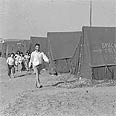David HaCohen Clandestine Immigration and Naval Museum
This is the story of a ship (like others of its time), that played an important role in the effort to bring Jews to the coveted pre-State shores. With its sister ships, it later helped build a fledgling country's Navy.
The museum is a testament to the 14-year era, known as ha'apala, or clandestine immigration, that lasted from 1934 to 1948. This was the struggle to bring Jews to Eretz Israel.
It was during this time that the British published the White Paper imposing strict immigration quotas and forbidding Jews to own land in the area the British ruled.
During the era of clandestine immigration 122,419 people were brought to Eretz Israel by 116 ships (the vast majority between 1945-1948).
The Clandestine Immigration and Naval Museum is literally built around a ship, the Af Al Pi Chen ("Nevertheless"). The Af Al Pi Chen was built in Canada in 1941 as a tank carrier. It served the Allied forces in the invasion of North Africa against Rommel's troops.
Later, the ship was purchased by an Italian shipping company and was used to haul agricultural products. Eventually the ship landed in the hands of the "Mossad le Aliyah Bet," one of the primary forces active in the Ha'apala.
In September, 1947, the British captured the Af Al Pi Chen and its 434 passengers were sent to Cyprus, where they were interned. The most famous ship from the clandestine immigration era, the Exodus, also did not manage to make it through the British blockade, and it, too, lost its struggle to British destroyers.
The Exodus was captured, turned away and her 4,530 passengers were returned to Europe, from where they had just fled. In fact they were deported to Hamburg, Germany.
After its service during the Ha'apala, the Af Al Pi Chen became part of the Israeli Navy. But due to technical issues never really served in active duty (the order to establish the Naval Service was given on March 17, 1948, prior to the actual declaration of independence).
Ultimately, the ship was sectioned into three pieces. In 1968 work began to reassemble the last remnants of the clandestine immigration era.
The museum opened in 1969, and it is a treasure trove that covers two separate but related subjects, the era of clandestine immigration and the Israeli Navy. While these are two distinct subjects they are closely related. The ships used during the Ha'apala served as the first ships in Israel's Navy.
The museum only partially covers the story of the Navy up, to 1973. In contrast, it presents the story of the Ha'apala in a very comprehensive manner and brings this pre-independence period to life. This was a time when many people tried to reach Eretz Israel and instead were interned in camps in Cyprus and Mauritius, or deported to Europe. This isn't a fancy museum, but a fascinating one, nonetheless. It is is one 11 Defense Ministry museums.
The museum features four audio-visual programs. In the entry hall a map outlines the routes taken by the various ships that participated in the Ha'apala and a seven-minute program provides an introduction to the subject of clandestine immigration. Additional audiovisual programs include:
- "The Struggle"
- "Cyprus is also Eretz Israel"
- "From Shore to Shore"
The David HaCohen Clandestine Immigration and Naval Museum is located within walking distance from the National Maritime Museum and Elijah's Cave.
- Address: 204 Allenby Street, Haifa
- Tel: +972.4.853.6249, +972.4.853.7672
Reprinted with permission from Gems in Israel , a Travel and Events in Israel website
















